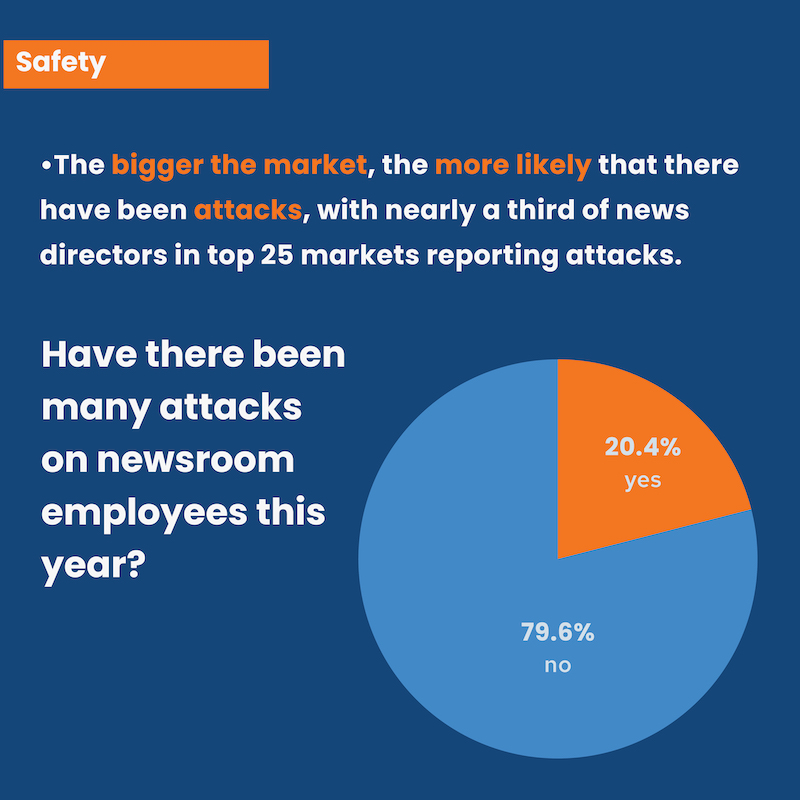RTDNA: 20% of TV News Directors Report Attacks on Journalists
The problem was even more widespread in larger markets, with 31% reporting attacks on their journalists

WASHINGTON D.C.—The problem of violence against journalists continued at troubling levels in 2021 according to latest RTDNA/Newhouse School at Syracuse University Survey, which found that more than one in five TV news directors (20.4%) reported there had been an attack on their newsroom employees in 2021 and that the problem with even bigger in larger markets.
In the top 25 DMAs, nearly one third (31%) of news directors reported attacks on journalists.
While the overall level was lower than 2020, news directors in markets 101 and smaller reported increases in attacks compared to 2020. Journalism is most dangerous in the West and then Northeast — less dangerous in the South, the RTDNA said.
A majority of TV news directors (52.2%) thought that 2021 was about the same in danger to journalists as 2020; more than a quarter (27.4%) thought 2021 was more dangerous, and 20.4% thought it was less dangerous.
Interestingly, there wasn’t much difference based on market size or staff size, network affiliation or region in those perceptions, the RTDNA reported.
A year ago, almost half of the attacks were against crews covering what news directors described as riots, protests and civil unrest, the group said.
This year, attacks were much more varied and seemingly random, with survey respondents reporting these examples of violence:
The professional video industry's #1 source for news, trends and product and tech information. Sign up below.
- One photographer was attacked while covering an out-of-hand fraternity party
- One reporter was approached on the street and hit unprovoked
- One reporter had a drink thrown at them from a car
- Police detained a news crew covering a protest
- One crew had its car surrounded by a group of people, who shook and pounded on it
- Multiple reporters were spit on, and one was spit on several times
- One photographer was hit in the face by a rock
- One photographer was punched at a crime scene
- Several reporters were the victims of racist verbal harassment
- One anchor received a death threat
- Several crews had their gear damaged or broken
- Several TV news directors reported their staff receives constant harassment, whether via phone calls or emails.
Overall, the survey found that the level of attacks at radio stations and on radio news people is much lower.
“Of radio news directors and general managers, 3% reported attacks on newsroom employees,” the RTDNA reported. “A year ago, it was primarily a problem in major markets, with 1 million and more people. This past year, market size made no meaningful difference. A year ago, region made no difference. This time, most of the attacks were in the West and Midwest, and news directors and general managers in the West were more than twice as likely to say 2021 was more dangerous than the year before.”
More than three-quarters (77%) of radio news directors and general managers thought the level of danger for journalists was about the same in 2021 as it was in 2020, the group said. Fourteen percent said it was more dangerous; nine percent said less.
This research was supported by the S. I. Newhouse School of Public Communications at Syracuse University and the Radio Television Digital News Association.
The research was led by Bob Papper, Adjunct Professor of Broadcast and Digital Journalism at Syracuse University who has worked extensively in radio and TV news and Keren Henderson is Associate Professor of Broadcast and Digital Journalism at Syracuse.
The RTDNA/Newhouse School at Syracuse University Survey was conducted in the fourth quarter of 2021 among all 1,780 operating, non-satellite television stations and a random sample of 3,379 radio stations. Valid responses came from as many as 1,336 television stations (75.1%) and 765 radio news directors and general managers representing 2,310 radio stations. Some data sets (e.g. the number of TV stations originating local news, getting it from others and women TV news directors) are based on a complete census and are not projected from a smaller sample.
Additional data is available here.
George Winslow is the senior content producer for TV Tech. He has written about the television, media and technology industries for nearly 30 years for such publications as Broadcasting & Cable, Multichannel News and TV Tech. Over the years, he has edited a number of magazines, including Multichannel News International and World Screen, and moderated panels at such major industry events as NAB and MIP TV. He has published two books and dozens of encyclopedia articles on such subjects as the media, New York City history and economics.

